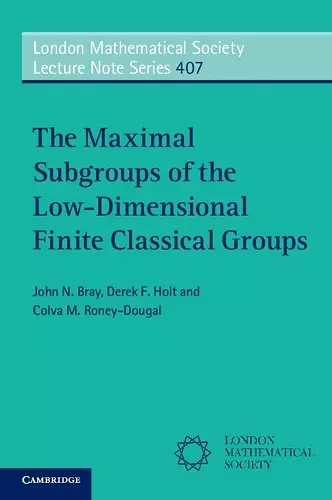The Maximal Subgroups of the Low-Dimensional Finite Classical Groups
John N Bray author Derek F Holt author Colva M Roney-Dougal author
Format:Paperback
Publisher:Cambridge University Press
Published:25th Jul '13
Currently unavailable, and unfortunately no date known when it will be back

Classifies the maximal subgroups of the finite groups of Lie type up to dimension 12, using theoretical and computational methods.
This book classifies the maximal subgroups of finite classical groups in low dimension. It features previously unseen results and over 100 tables, making this an essential reference for researchers. It will appeal to graduate students as a textbook on finite simple groups, computational group theory (including Magma) and representation theory.This book classifies the maximal subgroups of the almost simple finite classical groups in dimension up to 12; it also describes the maximal subgroups of the almost simple finite exceptional groups with socle one of Sz(q), G2(q), 2G2(q) or 3D4(q). Theoretical and computational tools are used throughout, with downloadable Magma code provided. The exposition contains a wealth of information on the structure and action of the geometric subgroups of classical groups, but the reader will also encounter methods for analysing the structure and maximality of almost simple subgroups of almost simple groups. Additionally, this book contains detailed information on using Magma to calculate with representations over number fields and finite fields. Featured within are previously unseen results and over 80 tables describing the maximal subgroups, making this volume an essential reference for researchers. It also functions as a graduate-level textbook on finite simple groups, computational group theory and representation theory.
'The study of the maximal subgroups of the finite classical groups started long ago. Their understanding has been crucial in the work on the classification of finite simple groups. The methods [in this book] efficiently combine theoretical techniques together with computer algebra systems (GAP, Magma), with the computational files available [online] … The theoretical literature on the subject is highly exploited, especially Aschbacher's results which describe the maximal subgroups of most of the finite almost simple classical groups … The tables are packed with a great amount of information, and should satisfy the reader who is looking for some specific information about the structure of the maximal subgroups of a given classical group.' Nadia P. Mazza, Mathematical Reviews
ISBN: 9780521138604
Dimensions: 228mm x 152mm x 23mm
Weight: 640g
452 pages